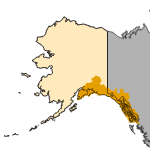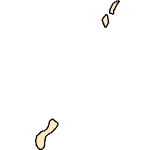Oncorhynchus clarkii
(Cutthroat Trout)
Fishes
Native Transplant |
|
Common name: Cutthroat Trout
Synonyms and Other Names: Salmo clarki
Taxonomy: available through
www.itis.gov
Identification: Scott and Crossman (1973); Moyle (1976a); Morrow (1980); Sublette et al. (1990); Page and Burr (1991); Behnke (1992). Behnke (1992) recognized 14 subspecies and provided information on each one. This species was formerly known as Salmo clarki.
Size: 99 cm.
Native Range: Pacific Coast drainages from Prince William Sound, Alaska, to Eel River, northern California. Freshwater populations range through Rocky Mountains to Hudson Bay, Mississippi River, Great (including Lahontan, Bonneville, and Alvord basins), and Pacific basins from southern Alberta to Rio Grande drainage, New Mexico (Page and Burr 1991).



|

Alaska |

Hawaii |

Puerto Rico &
Virgin Islands |

Guam Saipan |
Hydrologic Unit Codes (HUCs) Explained
Interactive maps: Point Distribution Maps
Nonindigenous Occurrences:
Table 1. States with nonindigenous occurrences, the earliest and latest observations in each state, and the tally and names of HUCs with observations†. Names and dates are hyperlinked to their relevant specimen records. The list of references for all nonindigenous occurrences of Oncorhynchus clarkii are found here.
Table last updated 12/18/2025
† Populations may not be currently present.
* HUCs are not listed for states where the observation(s) cannot be approximated to a HUC (e.g. state centroids or Canadian provinces).
Means of Introduction: Many introductions resulted from authorized stocking for sportfishing. Escaped from a fish hatchery in Virginia. Fine-spotted Snake River cutthroat from Wyoming were stocked in Arkansas in 1984 (Robison and Buchanan 1988). Yellowstone, Lahantan and perhaps other subspecies have been stocked in Arizona (Minckley 1973). Paiute (Moyle 1976a), Yellowstone (Dill and Cordone 1997), and probably coastal and Lahontan cutthroat have been transplanted outside their native ranges in California. The state of Colorado planted Yellowstone cutthroats exclusively until sometime after 1974 (Beckman 1974). Since then, Snake River cutthroats have also been stocked in the state (Walker 1993). Both species have been stocked in the same drainages (Walker 1993). Greenback, Colorado River, and Rio Grande cutthroat are native to the state (Walker 1993). Yellowfin cutthroat, formerly native to Twin Lakes, Colorado, is now extinct (Walker 1993). Stocked numerous times since the late 1800s in Connecticut (Whitworth 1996). Lahontan, Bear Lake (Idaho Fish and Game 1997), and perhaps westslope cutthroats (Simpson and Wallace 1978) have been introduced into nonnative areas of Idaho. The Yellowstone subspecies was introduced into Michigan (Hubbs and Lagler 1947). Westslope (Eddy and Underhill 1974) and Lahontan cutthroat (La Rivers 1962) were introduced into Minnesota. Bonneville, and Lahontan (La Rivers 1962), Yellowstone, greenback (Deacon and Williams 1984), Rio Grande, fine-spotted Snake River, and Yellowstone (Sublette et al. 1990) cutthroat subspecies have all been introduced in nonnative areas of Nevada. Yellowstone cutthroat were introduced in Oregon (Bond 1973) and Washington (Schultz and DeLacy 1935). Lahontan cutthroat were recently introduced into Washington (Washington Department of Fish and Wildlife 1997). Westslope (Sigler and Miller 1963), greenback (Tyus et al. 1982), and Yellowstone (Sigler and Sigler 1996) cutthroat were introduced to nonnative areas in Utah. The Lahontan (La Rivers 1962) and Colorado River (Gorges 1994) cutthroat were introduced in Wyoming. Unknown subspecies were stocked in Connecticut, Nebraska, New Jersey, Tennessee, and Wisconsin. Miller et al. (1991) recounted a story of an early trout introduction told to Carl Hubbs by a Nevada pioneer George Schmidtlein. In 1873, George gathered together family and neighbors, including a native American, to transfer Cutthroat Trout O. clarki henshawi from the Reese River system to his pond in Big Smoky Valley. The group, with the use of a hired mule train, spent more than four days transporting the fish live in vinegar kegs over several mountain summits. These fish, or their progeny, eventually spread to many of the area streams. In Maryland scaped juveniles were found in a creek downstream from a fish hatchery (D. Neely, personal communication; Frostburg State University museum). Between 1895-1940, 105,000 fish were stocked in Newaygo County, Michigan (Fukano et al. 1964).
Status: Established in Arizona, California, Colorado, Nevada, and Utah. Most stocking attempts in other states failed (e.g., Tennessee, Connecticut, Minnesota) or populations replenished with repeated stockings. Established for a time in Michigan, then died out (Hubbs and Lagler 1947, 1964; Becker 1983).
Impact of Introduction: Indiscriminate stocking has obscured recognition of many subspecies (Page and Burr 1991; Behnke 1992). Yellowstone cutthroat O. c. lewisi have hybridized extensively with Lahontan cutthroat O. c. henshawi in California (McAffee 1966). Cutthroat Trout also hybridize with rainbow trout in situations where one or both species have been introduced (Behnke 1992).
References: (click for full references)
Behnke, R.J. 1992. Native trout of western North America. American Fisheries Society Monograph 6. American Fisheries Society, Bethesda, MD.
Bradley, W. G. and J. E. Deacon. 1967. The biotic communities of southern Nevada. Nevada State Museum Anthropological Papers No. 13, Part 4. 201-273.
Cudmore-Vokey, B. and E.J. Crossman. 2000. Checklists of the fish fauna of the Laurentian Great Lakes and their connecting channels. Can. MS Rpt. Fish. Aquat. Sci. 2500: v + 39p.
Fukano, K.G., H. Gowing, M.J. Hansen, and L.N. Allison. 1964. Introduction of exotic fish into Michigan. Michigan Department of Conservation, Institute of Fisheries Research, Ann Arbor, MI.
Insider Viewpoint. 2001. Fishing Records – Nevada. Insider Viewpoint Magazine. 3 pp.
McAffee, W.R. 1966. Lahontan cutthroat trout. Pages 225-231 in Calhoun, A, ed. Inland fisheries management. California Department of Fish and Game. Sacramento, CA.
Miller, R.R. and C.H. Lowe. 1967. Part 2. Fishes of Arizona, p 133-151, In: C.H. Lowe, ed. The Vertebrates of Arizona. University of Arizona Press. Tucson.
Neely, D. - University of Alabama, Tuscaloosa, AL.
Page, L.M. and B.M. Burr. 1991. A Field Guide to Freshwater Fishes - North America North of Mexico. Volume 42. Houghton Mifflin Company, Boston, MA.
Tilmant, J.T. 1999. Management of nonindigenous aquatic fish in the U.S. National Park System. National Park Service. 50 pp.
Other Resources:
FishBase Summary
Author:
Fuller, P.
Revision Date: 6/28/2019
Peer Review Date: 8/18/2009
Citation Information:
Fuller, P., 2025, Oncorhynchus clarkii (Richardson, 1836): U.S. Geological Survey, Nonindigenous Aquatic Species Database, Gainesville, FL, https://nas.er.usgs.gov/queries/factsheet.aspx?SpeciesID=890, Revision Date: 6/28/2019, Peer Review Date: 8/18/2009, Access Date: 12/18/2025
This information is preliminary or provisional and is subject to revision. It is being provided to meet the need for timely best science. The information has not received final approval by the U.S. Geological Survey (USGS) and is provided on the condition that neither the USGS nor the U.S. Government shall be held liable for any damages resulting from the authorized or unauthorized use of the information.